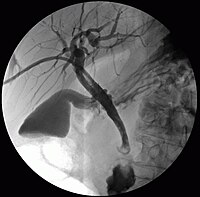
Photo from wikipedia
Background Despite advances in endoscopic drainage procedures, percutaneous transhepatic biliary drainage (PTBD) remains an essential interventional radiology (IR) procedure. Several factors may adversely affect the success of PTBD. We report… Click to show full abstract
Background Despite advances in endoscopic drainage procedures, percutaneous transhepatic biliary drainage (PTBD) remains an essential interventional radiology (IR) procedure. Several factors may adversely affect the success of PTBD. We report the experience of our IR unit with PTBD in patients considered at higher risk for adverse events. Material Consecutive PTBDs performed between November 2017 and April 2019 were retrospectively reviewed. The patients at increased risk for adverse events from PTBD, defined by one or more of the following factors: non-dilated system, moderate amount of perihepatic fluid, coagulopathy, altered sensorium, and PTBD performed at bedside, were identified. Technical success, complications, and outcome at 3 months were recorded. Results During the study period, PTBDs were performed in 90 patients. PTBDs in 57 (63.3%) patients (mean age 47.6 years, 35 females) were identified as predisposing to higher risk for adverse events. Left and right PTBD were performed in 37 (64.9%) and 15 (26.3%) patients, respectively. Bilateral PTBDs were performed in three (5.2%) patients. In two (3.5%) cases, biliary access was obtained via percutaneous cholecystostomy. Overall technical success of 91.2% ( n = 52) was achieved. Carcinoma gallbladder was the most common underlying cause. Non-dilated ductal system was the most common condition deemed to predispose to higher risk for adverse events ( n = 32, 56.1%), followed by perihepatic fluid (n = 9, 15.8%), and deranged coagulation parameters ( n = 9, 15.8%). PTBD was performed at bedside in intensive care unit in 5 (8.8%) patients. Two (3.5%) patients had altered sensorium. Major complications in the form of biliary peritonitis were observed in three (5.2%) patients. No procedure-related mortality was observed. Conclusion PTBD can be effectively and safely performed even in situations deemed to predispose patients to increased risk for adverse events. Thus, the mere presence of these conditions should not cause a denial of PTBD.
Journal Title: Abdominal Radiology
Year Published: 2019
Link to full text (if available)
Share on Social Media: Sign Up to like & get
recommendations!